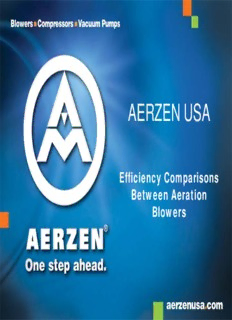
Efficiency Comparisons Between Aeration Blowers PDF
Preview Efficiency Comparisons Between Aeration Blowers
AERZEN USA Efficiency Comparisons Between Aeration Blowers Evaluation of Blower Technologies Introduction Aeration System Largest Consumer of Power in WWTP 50% to 60% of plant operating cost Life Cycle Costs far exceeds Initial Capital Costs Evaluation of Blower Technologies Introduction Purpose of Presentation Evolution of Blower Technologies Matching the Technology to the Application Right-Sizing of Blowers Accurate Evaluation of Overall Costs Evaluation of Blower Technologies Traditional Blower Technologies Two Lobe Positive Displacement Variable Speed Multi-Stage Centrifugal Inlet Throttle Valve or Guide Vanes Variable Speed Evaluation of Blower Technologies PD Blower Design Principles Positive Displacement Blower Constant volume against varying pressure Flow changes by varying speed with VFD Large Turndown (Typically 4:1) Easily adapts to changes in pressure & temperature Widely used / Low initial cost Evaluation of Blower Technologies PD Blower Evolution Two-Lobe to Three-Lobe Technology Pulsation Cancellation Less wear and tear on components and piping Single Forging of Shaft and Impeller Stronger, More Stable at Higher Speeds More Effective Noise Reduction Quieter packages Upgraded Seals (Piston Ring) Longer maintenance intervals on internals Evaluation of Blower Technologies 2-Lobe Conveying Cycle Atmospheric pressure System pressure Abrupt pressure equalization causes noise and shocks (pulsations) 4 times per revolution. Evaluation of Blower Technologies Three-Lobe Conveying Cycle Integrally cast return ports gradually pressurize casing Squeeze pulse is 180° out of phase with Pressure pulse. Evaluation of Blower Technologies Limitations of PD Blowers Efficiency Slip between Rotors Less efficient at Lower Flows Less efficient at Higher Pressure GM60S 0.68 %0.66 Y C0.64 N E0.62 CI FI 0.6 8 PSIG F E 10 PSIG C 0.58 12 PSIG TI A0.56 B A0.54 DI A0.52 0.5 0 500 1000 1500 2000 2500 INLET FLOW - ICFM Evaluation of Blower Technologies Compressor Design Principles Positive Displacement Compressor (VML) Used since the 1940’s (Deep Cell Aeration) Rotors mesh, compressing air inside housing Flow changes by varying speed (VFD) Best around 20 to 30 psig Higher capital cost (2X PD blower)
Description: